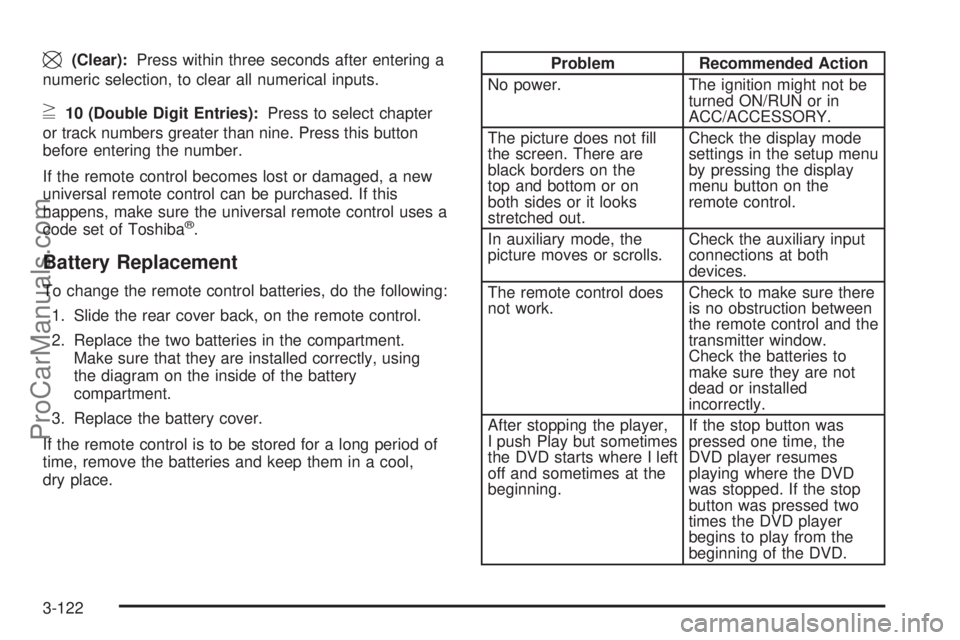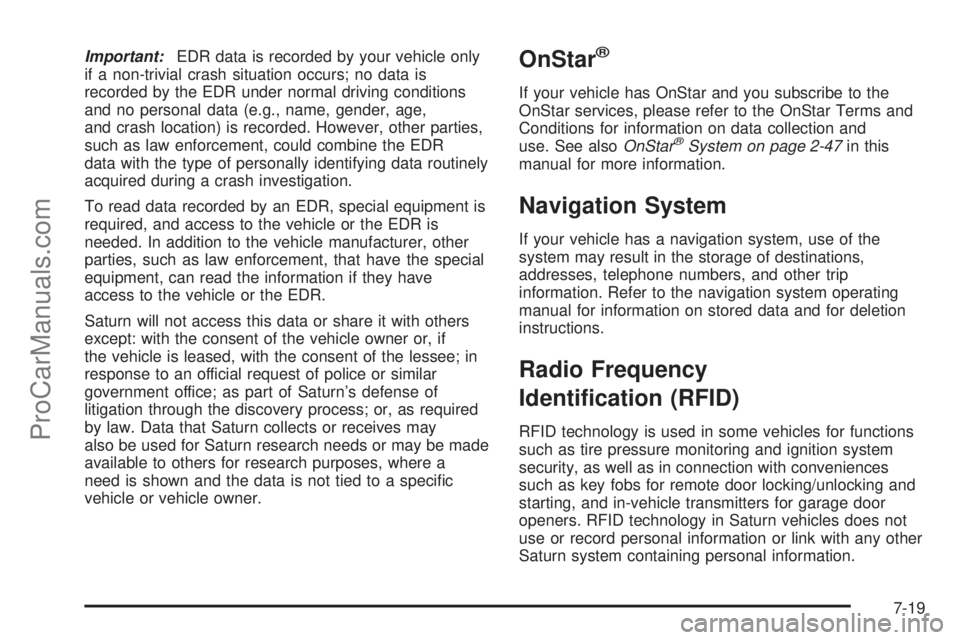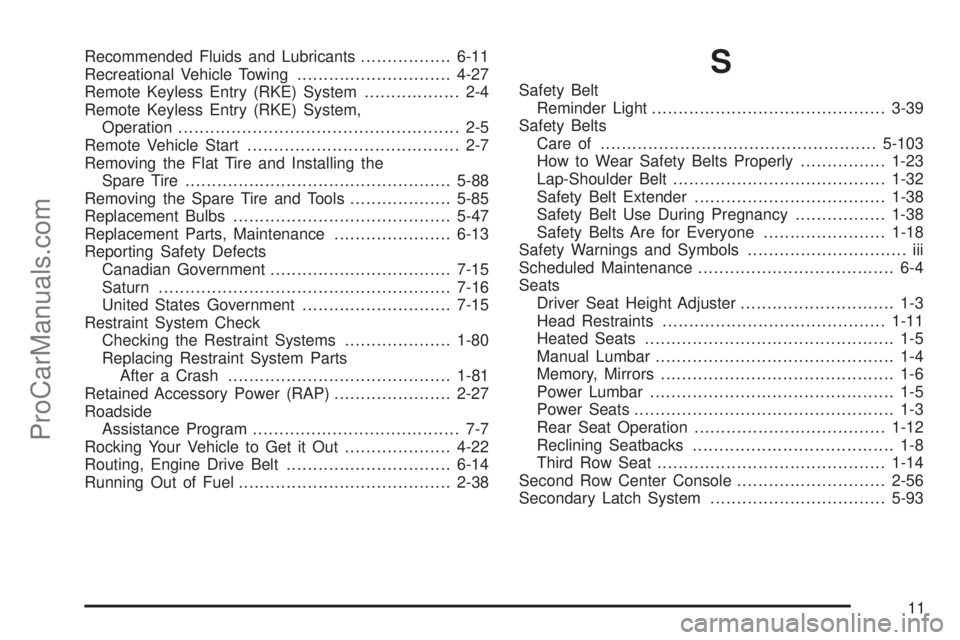remote start SATURN OUTLOOK 2008 Owner's Manual
[x] Cancel search | Manufacturer: SATURN, Model Year: 2008, Model line: OUTLOOK, Model: SATURN OUTLOOK 2008Pages: 488, PDF Size: 3 MB
Page 268 of 488

\(Clear):Press within three seconds after entering a
numeric selection, to clear all numerical inputs.
}10 (Double Digit Entries):Press to select chapter
or track numbers greater than nine. Press this button
before entering the number.
If the remote control becomes lost or damaged, a new
universal remote control can be purchased. If this
happens, make sure the universal remote control uses a
code set of Toshiba
®.
Battery Replacement
To change the remote control batteries, do the following:
1. Slide the rear cover back, on the remote control.
2. Replace the two batteries in the compartment.
Make sure that they are installed correctly, using
the diagram on the inside of the battery
compartment.
3. Replace the battery cover.
If the remote control is to be stored for a long period of
time, remove the batteries and keep them in a cool,
dry place.
Problem Recommended Action
No power. The ignition might not be
turned ON/RUN or in
ACC/ACCESSORY.
The picture does not �ll
the screen. There are
black borders on the
top and bottom or on
both sides or it looks
stretched out.Check the display mode
settings in the setup menu
by pressing the display
menu button on the
remote control.
In auxiliary mode, the
picture moves or scrolls.Check the auxiliary input
connections at both
devices.
The remote control does
not work.Check to make sure there
is no obstruction between
the remote control and the
transmitter window.
Check the batteries to
make sure they are not
dead or installed
incorrectly.
After stopping the player,
I push Play but sometimes
the DVD starts where I left
off and sometimes at the
beginning.If the stop button was
pressed one time, the
DVD player resumes
playing where the DVD
was stopped. If the stop
button was pressed two
times the DVD player
begins to play from the
beginning of the DVD.
3-122
ProCarManuals.com
Page 329 of 488

A. Radiator Pressure Cap (Out of View). SeeRadiator
Pressure Cap on page 5-23.
B. Engine Coolant Recovery Cap. SeeCooling System
on page 5-26.
C. Remote Negative (−) Terminal. SeeJump Starting
on page 5-38.
D. Underhood Fuse Block. SeeUnderhood Fuse Block
on page 5-115.
E. Remote Positive (+) Terminal. SeeJump Starting on
page 5-38.
F. Power Steering Fluid Reservoir (Out of View).
SeePower Steering Fluid on page 5-32.
G. Engine Oil Fill Cap. See “When to Add Engine Oil”
underEngine Oil on page 5-13.
H. Engine Oil Dipstick. See “Checking Engine Oil”
underEngine Oil on page 5-13.
I. Automatic Transmission Fluid Dipstick. See
“Checking the Fluid Level” underAutomatic
Transmission Fluid on page 5-20.
J. Brake Master Cylinder Reservoir. See “Brake Fluid”
underBrakes on page 5-34.K. Engine Air Cleaner/Filter. SeeEngine Air
Cleaner/Filter on page 5-18.
L. Windshield Washer Fluid Reservoir. See “Adding
Washer Fluid” underWindshield Washer Fluid
on page 5-33.
Engine Oil
Checking Engine Oil
It is a good idea to check the engine oil every time you
get fuel. In order to get an accurate reading, the oil
must be warm and the vehicle must be on level ground.
The engine oil dipstick handle is a yellow loop.
SeeEngine Compartment Overview on page 5-12
for the location of the engine oil dipstick.
1. Turn off the engine and give the oil several minutes
to drain back into the oil pan. If you do not do this,
the oil dipstick might not show the actual level.
2. Pull out the dipstick and clean it with a paper towel
or cloth, then push it back in all the way. Remove it
again, keeping the tip down, and check the level.
5-13
ProCarManuals.com
Page 355 of 488

Notice:Ignoring these steps could result in costly
damage to your vehicle that would not be covered
by your warranty.
Trying to start your vehicle by pushing or pulling it
will not work, and it could damage your vehicle.
1. Check the other vehicle. It must have a 12-volt
battery with a negative ground system.
Notice:If the other vehicle’s system is not a 12-volt
system with a negative ground, both vehicles can
be damaged. Only use vehicles with 12-volt systems
with negative grounds to jump start your vehicle.
2. Get the vehicles close enough so the jumper cables
can reach, but be sure the vehicles are not touching
each other. If they are, it could cause a ground
connection you do not want. You would not be
able to start your vehicle, and the bad grounding
could damage the electrical systems.
To avoid the possibility of the vehicles rolling, set
the parking brake �rmly on both vehicles involved
in the jump start procedure. Put an automatic
transmission in P (Park) or a manual transmission
in NEUTRAL before setting the parking brake. If you
have a four-wheel-drive vehicle, be sure the transfer
case is not in NEUTRAL.Notice:If you leave your radio or other accessories
on during the jump starting procedure, they could
be damaged. The repairs would not be covered
by your warranty. Always turn off your radio and
other accessories when jump starting your vehicle.
3. Turn off the ignition on both vehicles. Unplug
unnecessary accessories plugged into the cigarette
lighter or the accessory power outlets. Turn off the
radio and all lamps that are not needed. This will
avoid sparks and help save both batteries. And it
could save the radio!
4. Open the hoods and locate the positive (+) and
negative (−) terminal locations on the other vehicle.
Your vehicle has a remote positive (+) and a remote
negative (−) jump starting terminal. SeeEngine
Compartment Overview on page 5-12for more
information on the terminal locations.
5-39
ProCarManuals.com
Page 357 of 488

6. Connect the red
positive (+) cable to the
positive (+) terminal
of the dead battery.
Use a remote positive (+) terminal if the vehicle
has one.
7. Do not let the other end touch metal. Connect it to
the positive (+) terminal of the good battery. Use a
remote positive (+) terminal if the vehicle has one.
8. Now connect the black negative (−) cable to the
negative (−) terminal of the good battery. Use a
remote negative (−) terminal if the vehicle has one.
Do not let the other end touch anything until the
next step. The other end of the negative (−) cable
does not go to the dead battery. It goes to a heavy,
unpainted metal engine part, or to a remote
negative (−) terminal on the vehicle with the
dead battery.9. Connect the other
end of the negative (−)
cable at least 18 inches
(45 cm) away from the
dead battery, but not
near engine parts
that move.
The electrical connection is just as good there, and
the chance of sparks getting back to the battery
is much less.
Your vehicle has a remote negative (−) terminal for
this purpose.
10. Now start the vehicle with the good battery and run
the engine for a while.
11. Try to start the vehicle that had the dead battery.
If it will not start after a few tries, it probably needs
service.
5-41
ProCarManuals.com
Page 378 of 488

TPMS Sensor Matching Process
Each TPMS sensor has a unique identi�cation code.
Any time you rotate your vehicle’s tires or replace one
or more of the TPMS sensors, the identi�cation codes
will need to be matched to the new tire/wheel position.
The sensors are matched to the tire/wheel positions in
the following order: driver side front tire, passenger side
front tire, passenger side rear tire, and driver side rear tire
using a TPMS diagnostic tool. See your dealer/retailer for
service.
The TPMS sensors can also be matched to each
tire/wheel position by increasing or decreasing the
tire’s air pressure. If increasing the tire’s air pressure,
do not exceed the maximum in�ation pressure indicated
on the tire’s sidewall.
To decrease air-pressure out of a tire you can use the
pointed end of the valve cap, a pencil-style air pressure
gage, or a key.
You have two minutes to match the �rst tire/wheel
position, and �ve minutes overall to match all four
tire/wheel positions. If it takes longer than two minutes,
to match the �rst tire and wheel, or more than
�ve minutes to match all four tire and wheel positions
the matching process stops and you need to start over.The TPMS sensor matching process is outlined below:
1. Set the parking brake.
2. Turn the ignition switch to ON/RUN with the
engine off.
3. Press the Remote Keyless Entry (RKE) transmitter’s
LOCK and UNLOCK buttons at the same time for
approximately �ve seconds. The horn sounds twice
to signal the receiver is in relearn mode and TIRE
LEARNING ACTIVE message displays on the DIC
screen.
4. Start with the driver side front tire.
5. Remove the valve cap from the valve cap stem.
Activate the TPMS sensor by increasing or
decreasing the tire’s air pressure for �ve seconds,
or until a horn chirp sounds. The horn chirp, which
may take up to 30 seconds to sound, con�rms that
the sensor identi�cation code has been matched to
this tire and wheel position.
6. Proceed to the passenger side front tire, and repeat
the procedure in Step 5.
7. Proceed to the passenger side rear tire, and repeat
the procedure in Step 5.
5-62
ProCarManuals.com
Page 462 of 488

Who is Covered?
Roadside Assistance coverage is for the vehicle
operator, regardless of ownership. In Canada, a person
driving this vehicle without the consent of the owner
is not eligible for coverage.
Services Provided
The following services are provided in the U.S. and
Canada up to 5 years/100,000 miles (160 000 km),
whichever comes �rst, and, in Canada only, up
to a maximum of $100.
Fuel Delivery:Delivery of enough fuel for the
vehicle to get to the nearest service station
(approximately $5 Canada). In Canada, service to
provide diesel may be restricted. For safety reasons,
propane and other alternative fuels are not
provided through this service.
Lock-Out Service:Lock-out service is covered at
no charge if you are unable to gain entry into your
vehicle. A remote unlock may be available if
you have an active OnStar
®subscription. To ensure
security, the driver must present personal
identi�cation before lock-out service is provided. In
Canada, the vehicle registration is also required.
Emergency Tow From a Public Roadway or
Highway:Tow to the nearest Saturn retailer for
warranty service or in the event of a vehicle-disabling
crash. Winch-out assistance is provided when the
vehicle is mired in sand, mud, or snow.
Flat Tire Change:Installation of a spare tire in good
condition, when equipped and properly in�ated, is
covered at no charge. The customer is responsible
for the repair or replacement of the tire if not covered
by a warrantable failure.
Jump Start:A battery jump start is covered at no
charge if the vehicle does not start.
Trip Routing Service (Canada Only):Upon
request, Roadside Assistance will send you detailed,
computer personalized maps, highlighting your
choice of either the most direct route or the most
scenic route to your destination, anywhere in North
America, along with helpful travel information
pertaining to your trip.
Please allow three weeks before your planned
departure date. Trip routing requests are limited to
six per calendar year.
7-8
ProCarManuals.com
Page 473 of 488

Important:EDR data is recorded by your vehicle only
if a non-trivial crash situation occurs; no data is
recorded by the EDR under normal driving conditions
and no personal data (e.g., name, gender, age,
and crash location) is recorded. However, other parties,
such as law enforcement, could combine the EDR
data with the type of personally identifying data routinely
acquired during a crash investigation.
To read data recorded by an EDR, special equipment is
required, and access to the vehicle or the EDR is
needed. In addition to the vehicle manufacturer, other
parties, such as law enforcement, that have the special
equipment, can read the information if they have
access to the vehicle or the EDR.
Saturn will not access this data or share it with others
except: with the consent of the vehicle owner or, if
the vehicle is leased, with the consent of the lessee; in
response to an official request of police or similar
government office; as part of Saturn’s defense of
litigation through the discovery process; or, as required
by law. Data that Saturn collects or receives may
also be used for Saturn research needs or may be made
available to others for research purposes, where a
need is shown and the data is not tied to a speci�c
vehicle or vehicle owner.OnStar®
If your vehicle has OnStar and you subscribe to the
OnStar services, please refer to the OnStar Terms and
Conditions for information on data collection and
use. See alsoOnStar
®System on page 2-47in this
manual for more information.
Navigation System
If your vehicle has a navigation system, use of the
system may result in the storage of destinations,
addresses, telephone numbers, and other trip
information. Refer to the navigation system operating
manual for information on stored data and for deletion
instructions.
Radio Frequency
Identi�cation (RFID)
RFID technology is used in some vehicles for functions
such as tire pressure monitoring and ignition system
security, as well as in connection with conveniences
such as key fobs for remote door locking/unlocking and
starting, and in-vehicle transmitters for garage door
openers. RFID technology in Saturn vehicles does not
use or record personal information or link with any other
Saturn system containing personal information.
7-19
ProCarManuals.com
Page 485 of 488

Recommended Fluids and Lubricants.................6-11
Recreational Vehicle Towing.............................4-27
Remote Keyless Entry (RKE) System.................. 2-4
Remote Keyless Entry (RKE) System,
Operation..................................................... 2-5
Remote Vehicle Start........................................ 2-7
Removing the Flat Tire and Installing the
Spare Tire..................................................5-88
Removing the Spare Tire and Tools...................5-85
Replacement Bulbs.........................................5-47
Replacement Parts, Maintenance......................6-13
Reporting Safety Defects
Canadian Government..................................7-15
Saturn.......................................................7-16
United States Government............................7-15
Restraint System Check
Checking the Restraint Systems....................1-80
Replacing Restraint System Parts
After a Crash..........................................1-81
Retained Accessory Power (RAP)......................2-27
Roadside
Assistance Program....................................... 7-7
Rocking Your Vehicle to Get it Out....................4-22
Routing, Engine Drive Belt...............................6-14
Running Out of Fuel........................................2-38S
Safety Belt
Reminder Light............................................3-39
Safety Belts
Care of ....................................................5-103
How to Wear Safety Belts Properly................1-23
Lap-Shoulder Belt........................................1-32
Safety Belt Extender....................................1-38
Safety Belt Use During Pregnancy.................1-38
Safety Belts Are for Everyone.......................1-18
Safety Warnings and Symbols.............................. iii
Scheduled Maintenance..................................... 6-4
Seats
Driver Seat Height Adjuster............................. 1-3
Head Restraints..........................................1-11
Heated Seats............................................... 1-5
Manual Lumbar............................................. 1-4
Memory, Mirrors............................................ 1-6
Power Lumbar .............................................. 1-5
Power Seats................................................. 1-3
Rear Seat Operation....................................1-12
Reclining Seatbacks...................................... 1-8
Third Row Seat...........................................1-14
Second Row Center Console............................2-56
Secondary Latch System.................................5-93
11
ProCarManuals.com
Page 486 of 488

Securing a Child Restraint
Rear Seat Position......................................1-57
Right Front Seat Position..............................1-60
Security Light.................................................3-51
Service........................................................... 5-3
Accessories and Modi�cations......................... 5-3
Adding Equipment to the Outside of the
Vehicle..................................................... 5-5
California Perchlorate Materials Requirements..... 5-4
California Proposition 65 Warning.................... 5-4
Doing Your Own Work................................... 5-4
Engine Soon Light.......................................3-48
Publications Ordering Information...................7-16
Service, Scheduling Appointments.....................7-10
Servicing Your Airbag-Equipped Vehicle..............1-78
Setting the Clock............................................3-84
Sheet Metal Damage.....................................5-107
Shifting Into Park............................................2-35
Shifting Out of Park........................................2-36
Signals, Turn and Lane-Change.......................... 3-9
Spare Tire
Compact...................................................5-100
Installing....................................................5-88
Removing...................................................5-85
Storing.......................................................5-96
Speci�cations, Capacities...............................5-120
Speedometer..................................................3-39
StabiliTrak
®Indicator Light...............................3-46
Stabilitrak®System........................................... 4-6Start Vehicle, Remote....................................... 2-7
Starting the Engine.........................................2-27
Steering.......................................................... 4-9
Steering Wheel Controls, Audio.......................3-126
Steering Wheel, Power Tilt Wheel and
Telescopic Steering Column............................ 3-8
Steering Wheel, Tilt and Telescopic..................... 3-7
Storage Areas
Cargo Management System..........................2-59
Center Console Storage Area........................2-56
Convenience Net.........................................2-58
Cupholders.................................................2-55
Glove Box..................................................2-55
Instrument Panel Storage Area......................2-55
Luggage Carrier..........................................2-58
Rear Seat Armrest.......................................2-58
Second Row Center Console........................2-56
Stuck in Sand, Mud, Ice, or Snow.....................4-21
Sun Visors.....................................................2-21
Sunroof.........................................................2-60
T
Tachometer....................................................3-39
Taillamps
Turn Signal, Stoplamps and
Sidemarker Lamps...................................5-46
Telescopic Steering Column, Power Tilt Wheel...... 3-8
Telescopic Wheel.............................................. 3-7
12
ProCarManuals.com
Page 488 of 488

V
Vehicle
Control........................................................ 4-3
Damage Warnings........................................... iv
Loading......................................................4-22
Symbols......................................................... iv
Vehicle Customization, DIC..............................3-74
Vehicle Data Recording and Privacy..................7-18
Vehicle Identi�cation
Number (VIN)............................................5-109
Service Parts Identi�cation Label..................5-109
Vehicle, Remote Start....................................... 2-7
Ventilation Adjustment......................................3-34
Visors...........................................................2-21
Voltage Devices, High and Wiring....................5-110
Voltmeter Gage..............................................3-44
W
Warning Lights, Gages, and Indicators...............3-37
Warnings
DIC Warnings and Messages........................3-64
Hazard Warning Flashers............................... 3-6
Other Warning Devices.................................. 3-7
Safety and Symbols......................................... iii
Vehicle Damage.............................................. ivWheels
Alignment and Tire Balance..........................5-70
Different Size..............................................5-67
Replacement...............................................5-70
Where to Put the Restraint...............................1-48
Windows.......................................................2-18
Power ........................................................2-19
Windshield
Backglass, and Wiper Blades, Cleaning........5-105
Washer......................................................3-10
Washer Fluid..............................................5-33
Wiper Blade Replacement.............................5-48
Wiper Fuses.............................................5-110
Wipers.......................................................3-10
Windshield, Rear Washer/Wiper........................3-11
Winter Driving................................................4-17
Wiring, High Voltage Devices..........................5-110
X
XM Radio Messages.....................................3-114
Y
Your Vehicle and the Environment....................... 6-2
14
ProCarManuals.com